OFFENDER PROFILING.
VerifiedAdded on 2023/01/11
|10
|2812
|51
AI Summary
This is for a Criminal Psychology unit. It is a literature review, meaning it should focus on one journal article in particular but then reference 9 other sources (for a total of 10 sources). The topic is offender profiling, particularly exploring its efficacy, but also limitations it may have. The references should be scholarly journal articles only and we’ve been asked to use references published in the last 10 years; the 10 references should be written in the last 10 years, but reference to older pieces can be made on top of that. Despite being a Criminal Psychology unit, it can include a mix of criminology, criminal justice, legal journals, psychology, social work, or human welfare journals. You can use sub-headings; they are included in the word count. The reference list is not included in the word count. I've attached the rubric.
Contribute Materials
Your contribution can guide someone’s learning journey. Share your
documents today.

Running head: OFFENDER PROFILING 1
Offender Profiling
Name
Professor
Course
Date
Offender Profiling
Name
Professor
Course
Date
Secure Best Marks with AI Grader
Need help grading? Try our AI Grader for instant feedback on your assignments.
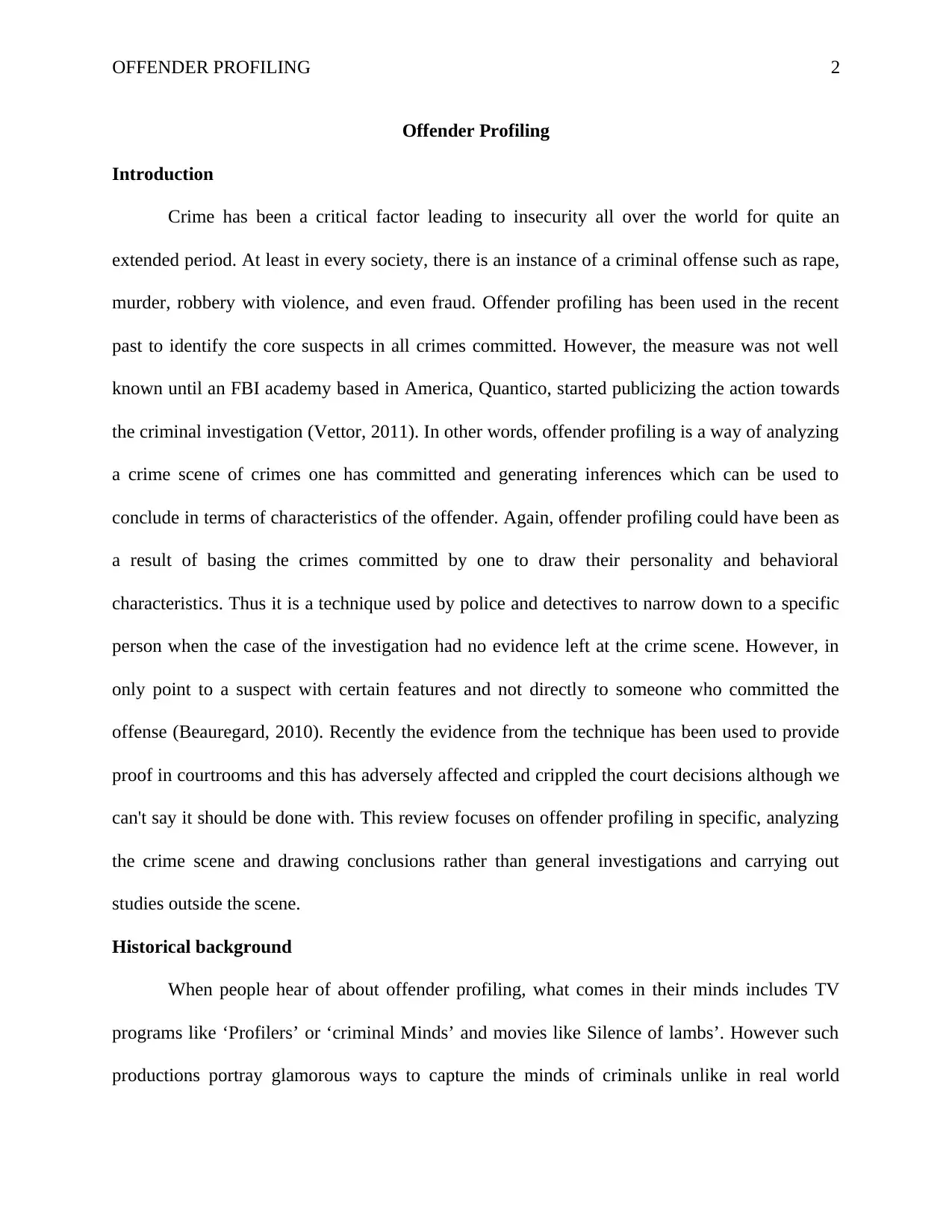
OFFENDER PROFILING 2
Offender Profiling
Introduction
Crime has been a critical factor leading to insecurity all over the world for quite an
extended period. At least in every society, there is an instance of a criminal offense such as rape,
murder, robbery with violence, and even fraud. Offender profiling has been used in the recent
past to identify the core suspects in all crimes committed. However, the measure was not well
known until an FBI academy based in America, Quantico, started publicizing the action towards
the criminal investigation (Vettor, 2011). In other words, offender profiling is a way of analyzing
a crime scene of crimes one has committed and generating inferences which can be used to
conclude in terms of characteristics of the offender. Again, offender profiling could have been as
a result of basing the crimes committed by one to draw their personality and behavioral
characteristics. Thus it is a technique used by police and detectives to narrow down to a specific
person when the case of the investigation had no evidence left at the crime scene. However, in
only point to a suspect with certain features and not directly to someone who committed the
offense (Beauregard, 2010). Recently the evidence from the technique has been used to provide
proof in courtrooms and this has adversely affected and crippled the court decisions although we
can't say it should be done with. This review focuses on offender profiling in specific, analyzing
the crime scene and drawing conclusions rather than general investigations and carrying out
studies outside the scene.
Historical background
When people hear of about offender profiling, what comes in their minds includes TV
programs like ‘Profilers’ or ‘criminal Minds’ and movies like Silence of lambs’. However such
productions portray glamorous ways to capture the minds of criminals unlike in real world
Offender Profiling
Introduction
Crime has been a critical factor leading to insecurity all over the world for quite an
extended period. At least in every society, there is an instance of a criminal offense such as rape,
murder, robbery with violence, and even fraud. Offender profiling has been used in the recent
past to identify the core suspects in all crimes committed. However, the measure was not well
known until an FBI academy based in America, Quantico, started publicizing the action towards
the criminal investigation (Vettor, 2011). In other words, offender profiling is a way of analyzing
a crime scene of crimes one has committed and generating inferences which can be used to
conclude in terms of characteristics of the offender. Again, offender profiling could have been as
a result of basing the crimes committed by one to draw their personality and behavioral
characteristics. Thus it is a technique used by police and detectives to narrow down to a specific
person when the case of the investigation had no evidence left at the crime scene. However, in
only point to a suspect with certain features and not directly to someone who committed the
offense (Beauregard, 2010). Recently the evidence from the technique has been used to provide
proof in courtrooms and this has adversely affected and crippled the court decisions although we
can't say it should be done with. This review focuses on offender profiling in specific, analyzing
the crime scene and drawing conclusions rather than general investigations and carrying out
studies outside the scene.
Historical background
When people hear of about offender profiling, what comes in their minds includes TV
programs like ‘Profilers’ or ‘criminal Minds’ and movies like Silence of lambs’. However such
productions portray glamorous ways to capture the minds of criminals unlike in real world
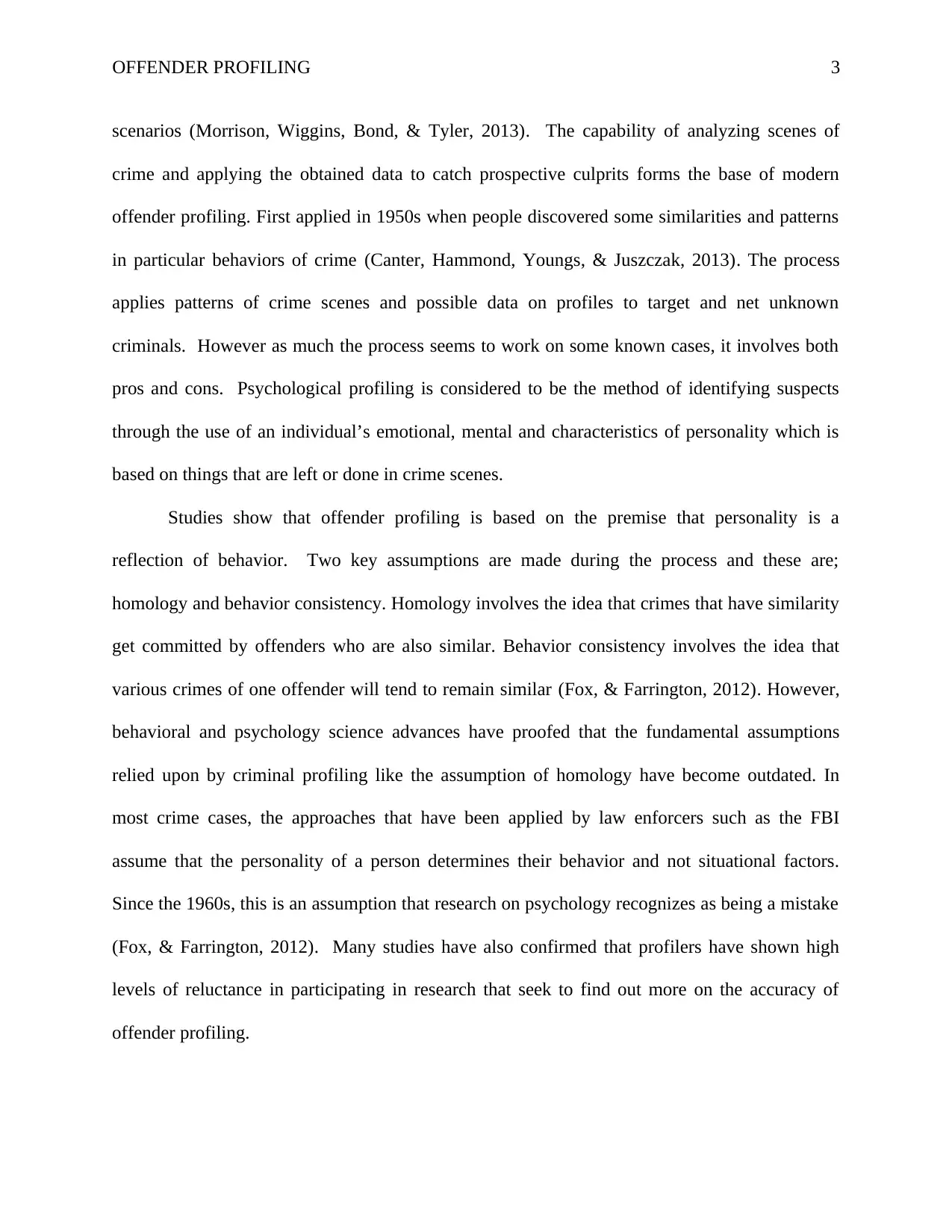
OFFENDER PROFILING 3
scenarios (Morrison, Wiggins, Bond, & Tyler, 2013). The capability of analyzing scenes of
crime and applying the obtained data to catch prospective culprits forms the base of modern
offender profiling. First applied in 1950s when people discovered some similarities and patterns
in particular behaviors of crime (Canter, Hammond, Youngs, & Juszczak, 2013). The process
applies patterns of crime scenes and possible data on profiles to target and net unknown
criminals. However as much the process seems to work on some known cases, it involves both
pros and cons. Psychological profiling is considered to be the method of identifying suspects
through the use of an individual’s emotional, mental and characteristics of personality which is
based on things that are left or done in crime scenes.
Studies show that offender profiling is based on the premise that personality is a
reflection of behavior. Two key assumptions are made during the process and these are;
homology and behavior consistency. Homology involves the idea that crimes that have similarity
get committed by offenders who are also similar. Behavior consistency involves the idea that
various crimes of one offender will tend to remain similar (Fox, & Farrington, 2012). However,
behavioral and psychology science advances have proofed that the fundamental assumptions
relied upon by criminal profiling like the assumption of homology have become outdated. In
most crime cases, the approaches that have been applied by law enforcers such as the FBI
assume that the personality of a person determines their behavior and not situational factors.
Since the 1960s, this is an assumption that research on psychology recognizes as being a mistake
(Fox, & Farrington, 2012). Many studies have also confirmed that profilers have shown high
levels of reluctance in participating in research that seek to find out more on the accuracy of
offender profiling.
scenarios (Morrison, Wiggins, Bond, & Tyler, 2013). The capability of analyzing scenes of
crime and applying the obtained data to catch prospective culprits forms the base of modern
offender profiling. First applied in 1950s when people discovered some similarities and patterns
in particular behaviors of crime (Canter, Hammond, Youngs, & Juszczak, 2013). The process
applies patterns of crime scenes and possible data on profiles to target and net unknown
criminals. However as much the process seems to work on some known cases, it involves both
pros and cons. Psychological profiling is considered to be the method of identifying suspects
through the use of an individual’s emotional, mental and characteristics of personality which is
based on things that are left or done in crime scenes.
Studies show that offender profiling is based on the premise that personality is a
reflection of behavior. Two key assumptions are made during the process and these are;
homology and behavior consistency. Homology involves the idea that crimes that have similarity
get committed by offenders who are also similar. Behavior consistency involves the idea that
various crimes of one offender will tend to remain similar (Fox, & Farrington, 2012). However,
behavioral and psychology science advances have proofed that the fundamental assumptions
relied upon by criminal profiling like the assumption of homology have become outdated. In
most crime cases, the approaches that have been applied by law enforcers such as the FBI
assume that the personality of a person determines their behavior and not situational factors.
Since the 1960s, this is an assumption that research on psychology recognizes as being a mistake
(Fox, & Farrington, 2012). Many studies have also confirmed that profilers have shown high
levels of reluctance in participating in research that seek to find out more on the accuracy of
offender profiling.
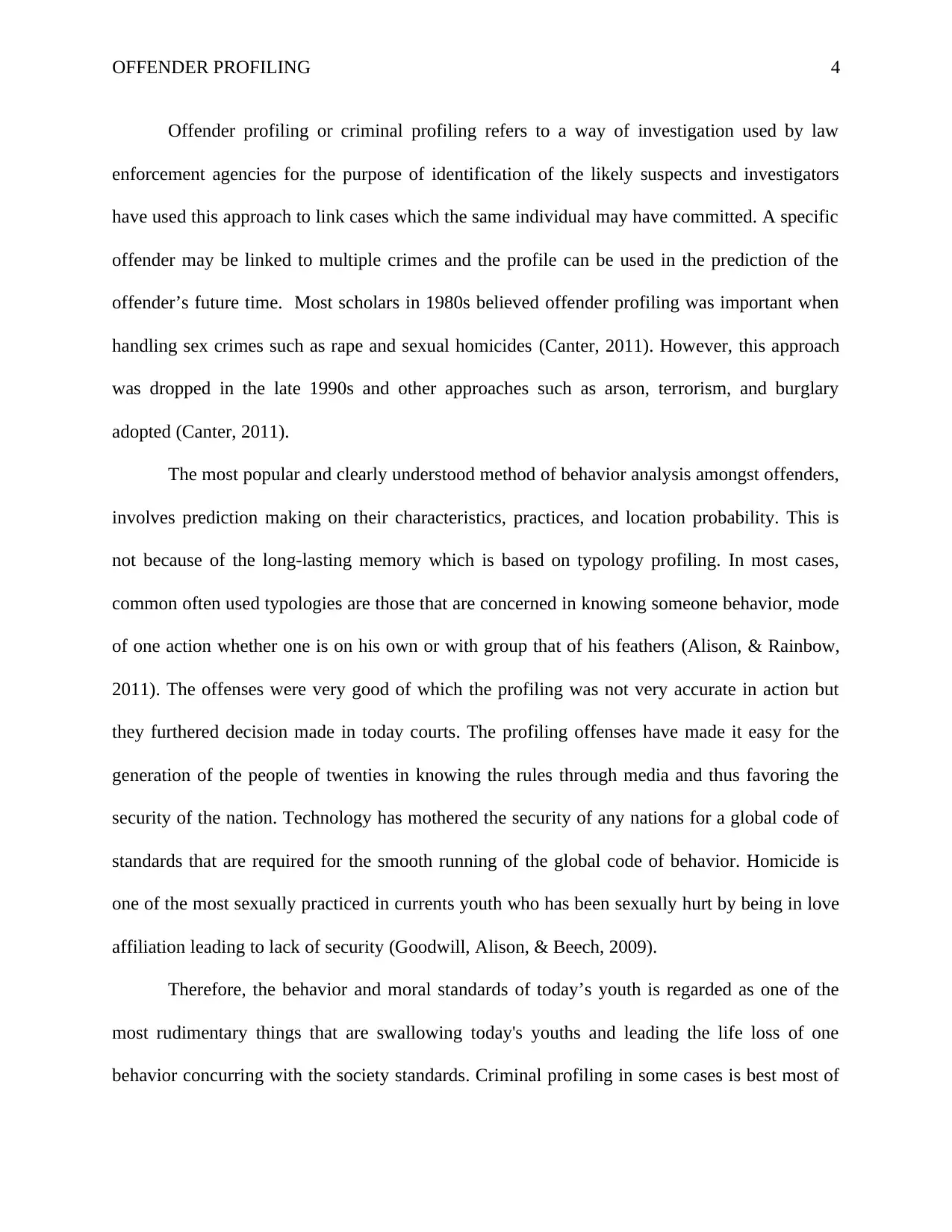
OFFENDER PROFILING 4
Offender profiling or criminal profiling refers to a way of investigation used by law
enforcement agencies for the purpose of identification of the likely suspects and investigators
have used this approach to link cases which the same individual may have committed. A specific
offender may be linked to multiple crimes and the profile can be used in the prediction of the
offender’s future time. Most scholars in 1980s believed offender profiling was important when
handling sex crimes such as rape and sexual homicides (Canter, 2011). However, this approach
was dropped in the late 1990s and other approaches such as arson, terrorism, and burglary
adopted (Canter, 2011).
The most popular and clearly understood method of behavior analysis amongst offenders,
involves prediction making on their characteristics, practices, and location probability. This is
not because of the long-lasting memory which is based on typology profiling. In most cases,
common often used typologies are those that are concerned in knowing someone behavior, mode
of one action whether one is on his own or with group that of his feathers (Alison, & Rainbow,
2011). The offenses were very good of which the profiling was not very accurate in action but
they furthered decision made in today courts. The profiling offenses have made it easy for the
generation of the people of twenties in knowing the rules through media and thus favoring the
security of the nation. Technology has mothered the security of any nations for a global code of
standards that are required for the smooth running of the global code of behavior. Homicide is
one of the most sexually practiced in currents youth who has been sexually hurt by being in love
affiliation leading to lack of security (Goodwill, Alison, & Beech, 2009).
Therefore, the behavior and moral standards of today’s youth is regarded as one of the
most rudimentary things that are swallowing today's youths and leading the life loss of one
behavior concurring with the society standards. Criminal profiling in some cases is best most of
Offender profiling or criminal profiling refers to a way of investigation used by law
enforcement agencies for the purpose of identification of the likely suspects and investigators
have used this approach to link cases which the same individual may have committed. A specific
offender may be linked to multiple crimes and the profile can be used in the prediction of the
offender’s future time. Most scholars in 1980s believed offender profiling was important when
handling sex crimes such as rape and sexual homicides (Canter, 2011). However, this approach
was dropped in the late 1990s and other approaches such as arson, terrorism, and burglary
adopted (Canter, 2011).
The most popular and clearly understood method of behavior analysis amongst offenders,
involves prediction making on their characteristics, practices, and location probability. This is
not because of the long-lasting memory which is based on typology profiling. In most cases,
common often used typologies are those that are concerned in knowing someone behavior, mode
of one action whether one is on his own or with group that of his feathers (Alison, & Rainbow,
2011). The offenses were very good of which the profiling was not very accurate in action but
they furthered decision made in today courts. The profiling offenses have made it easy for the
generation of the people of twenties in knowing the rules through media and thus favoring the
security of the nation. Technology has mothered the security of any nations for a global code of
standards that are required for the smooth running of the global code of behavior. Homicide is
one of the most sexually practiced in currents youth who has been sexually hurt by being in love
affiliation leading to lack of security (Goodwill, Alison, & Beech, 2009).
Therefore, the behavior and moral standards of today’s youth is regarded as one of the
most rudimentary things that are swallowing today's youths and leading the life loss of one
behavior concurring with the society standards. Criminal profiling in some cases is best most of
Secure Best Marks with AI Grader
Need help grading? Try our AI Grader for instant feedback on your assignments.
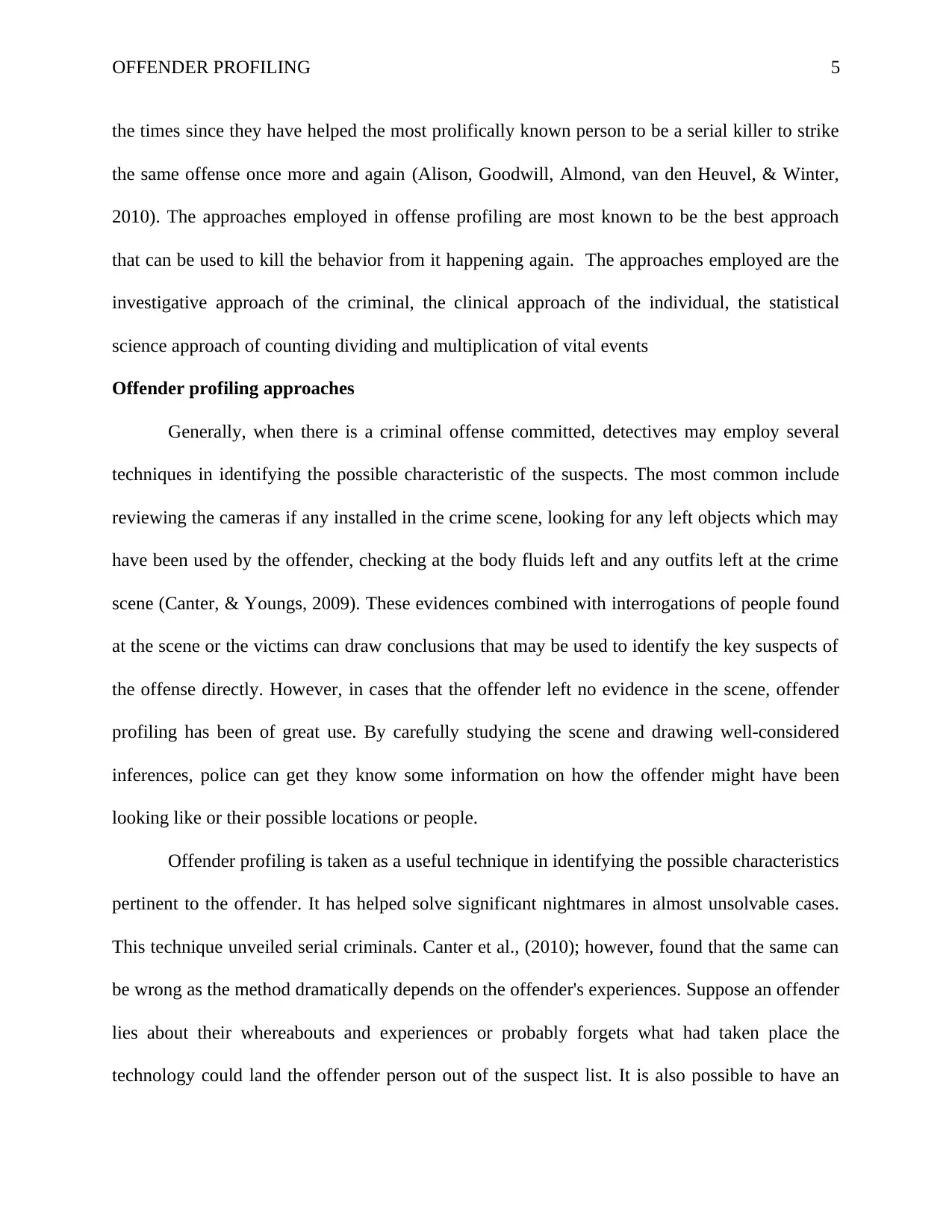
OFFENDER PROFILING 5
the times since they have helped the most prolifically known person to be a serial killer to strike
the same offense once more and again (Alison, Goodwill, Almond, van den Heuvel, & Winter,
2010). The approaches employed in offense profiling are most known to be the best approach
that can be used to kill the behavior from it happening again. The approaches employed are the
investigative approach of the criminal, the clinical approach of the individual, the statistical
science approach of counting dividing and multiplication of vital events
Offender profiling approaches
Generally, when there is a criminal offense committed, detectives may employ several
techniques in identifying the possible characteristic of the suspects. The most common include
reviewing the cameras if any installed in the crime scene, looking for any left objects which may
have been used by the offender, checking at the body fluids left and any outfits left at the crime
scene (Canter, & Youngs, 2009). These evidences combined with interrogations of people found
at the scene or the victims can draw conclusions that may be used to identify the key suspects of
the offense directly. However, in cases that the offender left no evidence in the scene, offender
profiling has been of great use. By carefully studying the scene and drawing well-considered
inferences, police can get they know some information on how the offender might have been
looking like or their possible locations or people.
Offender profiling is taken as a useful technique in identifying the possible characteristics
pertinent to the offender. It has helped solve significant nightmares in almost unsolvable cases.
This technique unveiled serial criminals. Canter et al., (2010); however, found that the same can
be wrong as the method dramatically depends on the offender's experiences. Suppose an offender
lies about their whereabouts and experiences or probably forgets what had taken place the
technology could land the offender person out of the suspect list. It is also possible to have an
the times since they have helped the most prolifically known person to be a serial killer to strike
the same offense once more and again (Alison, Goodwill, Almond, van den Heuvel, & Winter,
2010). The approaches employed in offense profiling are most known to be the best approach
that can be used to kill the behavior from it happening again. The approaches employed are the
investigative approach of the criminal, the clinical approach of the individual, the statistical
science approach of counting dividing and multiplication of vital events
Offender profiling approaches
Generally, when there is a criminal offense committed, detectives may employ several
techniques in identifying the possible characteristic of the suspects. The most common include
reviewing the cameras if any installed in the crime scene, looking for any left objects which may
have been used by the offender, checking at the body fluids left and any outfits left at the crime
scene (Canter, & Youngs, 2009). These evidences combined with interrogations of people found
at the scene or the victims can draw conclusions that may be used to identify the key suspects of
the offense directly. However, in cases that the offender left no evidence in the scene, offender
profiling has been of great use. By carefully studying the scene and drawing well-considered
inferences, police can get they know some information on how the offender might have been
looking like or their possible locations or people.
Offender profiling is taken as a useful technique in identifying the possible characteristics
pertinent to the offender. It has helped solve significant nightmares in almost unsolvable cases.
This technique unveiled serial criminals. Canter et al., (2010); however, found that the same can
be wrong as the method dramatically depends on the offender's experiences. Suppose an offender
lies about their whereabouts and experiences or probably forgets what had taken place the
technology could land the offender person out of the suspect list. It is also possible to have an

OFFENDER PROFILING 6
innocent person being interviewed and then forgets about their experiences but decides to lie and
accidentally gives information in line with the crime. The result is that this honest person shall
undoubtedly land in jail for an offense they never committed. Basing from the above findings of
Canter et al., (2010), we can say that offender profiling findings can be wrong and end up
releasing the guilty and jailing the innocent.
Efficacy/ pros of offender profiling
There are various pros that relate of criminal or offender profiling. One of them is that it
offers useful investigative information about a criminal. When no one is there to act as a witness
against a criminal or CCTV footage to show evidence, then offender profiling comes in to help.
It also predicts where unlawful acts are possible in future. It also offers investigators data to
work on no matter how little it is (Canter, 2010). Even with modern technologies such as facial
recognition or internet tracking. Offenders still escape this network. However, through the
examination of criminal conduct at crime scenes, it becomes possible to have a rough idea of the
most probable suspect. This allows for leads of being pursued even when the actual offender
identity is not there. Criminal profiling creates victim protection at some levels (Beauregard,
2010). For instance, when law enforcers notice that criminals target specific demographics, they
can warn such a group and focus on protecting them to avoid them being the next victims. It
serves as a good resource for some serious crimes.
In most cases, criminal profiling happens in homicide and others serious cases like
robbery, rape done. It helps evaluate the characteristics of potential offenders to come up with a
profile of people who could be culprits. These resources help catch violent offenders and such
profiles have helped in proactive prevention of some crimes from taking place. It gives personal
characteristics that help in solving investigations (Goodwill, Alison, & Beech, 2009). Profiling
innocent person being interviewed and then forgets about their experiences but decides to lie and
accidentally gives information in line with the crime. The result is that this honest person shall
undoubtedly land in jail for an offense they never committed. Basing from the above findings of
Canter et al., (2010), we can say that offender profiling findings can be wrong and end up
releasing the guilty and jailing the innocent.
Efficacy/ pros of offender profiling
There are various pros that relate of criminal or offender profiling. One of them is that it
offers useful investigative information about a criminal. When no one is there to act as a witness
against a criminal or CCTV footage to show evidence, then offender profiling comes in to help.
It also predicts where unlawful acts are possible in future. It also offers investigators data to
work on no matter how little it is (Canter, 2010). Even with modern technologies such as facial
recognition or internet tracking. Offenders still escape this network. However, through the
examination of criminal conduct at crime scenes, it becomes possible to have a rough idea of the
most probable suspect. This allows for leads of being pursued even when the actual offender
identity is not there. Criminal profiling creates victim protection at some levels (Beauregard,
2010). For instance, when law enforcers notice that criminals target specific demographics, they
can warn such a group and focus on protecting them to avoid them being the next victims. It
serves as a good resource for some serious crimes.
In most cases, criminal profiling happens in homicide and others serious cases like
robbery, rape done. It helps evaluate the characteristics of potential offenders to come up with a
profile of people who could be culprits. These resources help catch violent offenders and such
profiles have helped in proactive prevention of some crimes from taking place. It gives personal
characteristics that help in solving investigations (Goodwill, Alison, & Beech, 2009). Profiling
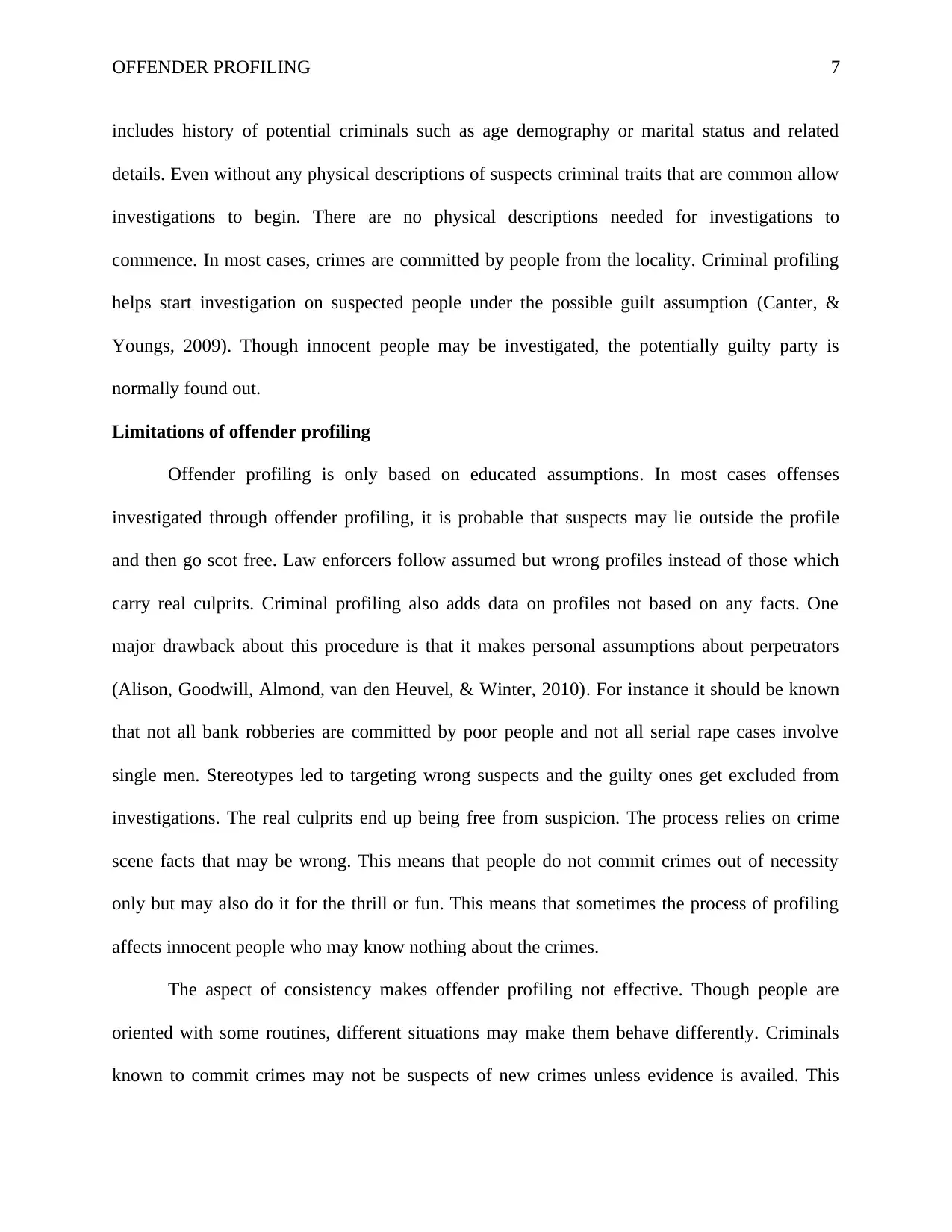
OFFENDER PROFILING 7
includes history of potential criminals such as age demography or marital status and related
details. Even without any physical descriptions of suspects criminal traits that are common allow
investigations to begin. There are no physical descriptions needed for investigations to
commence. In most cases, crimes are committed by people from the locality. Criminal profiling
helps start investigation on suspected people under the possible guilt assumption (Canter, &
Youngs, 2009). Though innocent people may be investigated, the potentially guilty party is
normally found out.
Limitations of offender profiling
Offender profiling is only based on educated assumptions. In most cases offenses
investigated through offender profiling, it is probable that suspects may lie outside the profile
and then go scot free. Law enforcers follow assumed but wrong profiles instead of those which
carry real culprits. Criminal profiling also adds data on profiles not based on any facts. One
major drawback about this procedure is that it makes personal assumptions about perpetrators
(Alison, Goodwill, Almond, van den Heuvel, & Winter, 2010). For instance it should be known
that not all bank robberies are committed by poor people and not all serial rape cases involve
single men. Stereotypes led to targeting wrong suspects and the guilty ones get excluded from
investigations. The real culprits end up being free from suspicion. The process relies on crime
scene facts that may be wrong. This means that people do not commit crimes out of necessity
only but may also do it for the thrill or fun. This means that sometimes the process of profiling
affects innocent people who may know nothing about the crimes.
The aspect of consistency makes offender profiling not effective. Though people are
oriented with some routines, different situations may make them behave differently. Criminals
known to commit crimes may not be suspects of new crimes unless evidence is availed. This
includes history of potential criminals such as age demography or marital status and related
details. Even without any physical descriptions of suspects criminal traits that are common allow
investigations to begin. There are no physical descriptions needed for investigations to
commence. In most cases, crimes are committed by people from the locality. Criminal profiling
helps start investigation on suspected people under the possible guilt assumption (Canter, &
Youngs, 2009). Though innocent people may be investigated, the potentially guilty party is
normally found out.
Limitations of offender profiling
Offender profiling is only based on educated assumptions. In most cases offenses
investigated through offender profiling, it is probable that suspects may lie outside the profile
and then go scot free. Law enforcers follow assumed but wrong profiles instead of those which
carry real culprits. Criminal profiling also adds data on profiles not based on any facts. One
major drawback about this procedure is that it makes personal assumptions about perpetrators
(Alison, Goodwill, Almond, van den Heuvel, & Winter, 2010). For instance it should be known
that not all bank robberies are committed by poor people and not all serial rape cases involve
single men. Stereotypes led to targeting wrong suspects and the guilty ones get excluded from
investigations. The real culprits end up being free from suspicion. The process relies on crime
scene facts that may be wrong. This means that people do not commit crimes out of necessity
only but may also do it for the thrill or fun. This means that sometimes the process of profiling
affects innocent people who may know nothing about the crimes.
The aspect of consistency makes offender profiling not effective. Though people are
oriented with some routines, different situations may make them behave differently. Criminals
known to commit crimes may not be suspects of new crimes unless evidence is availed. This
Paraphrase This Document
Need a fresh take? Get an instant paraphrase of this document with our AI Paraphraser
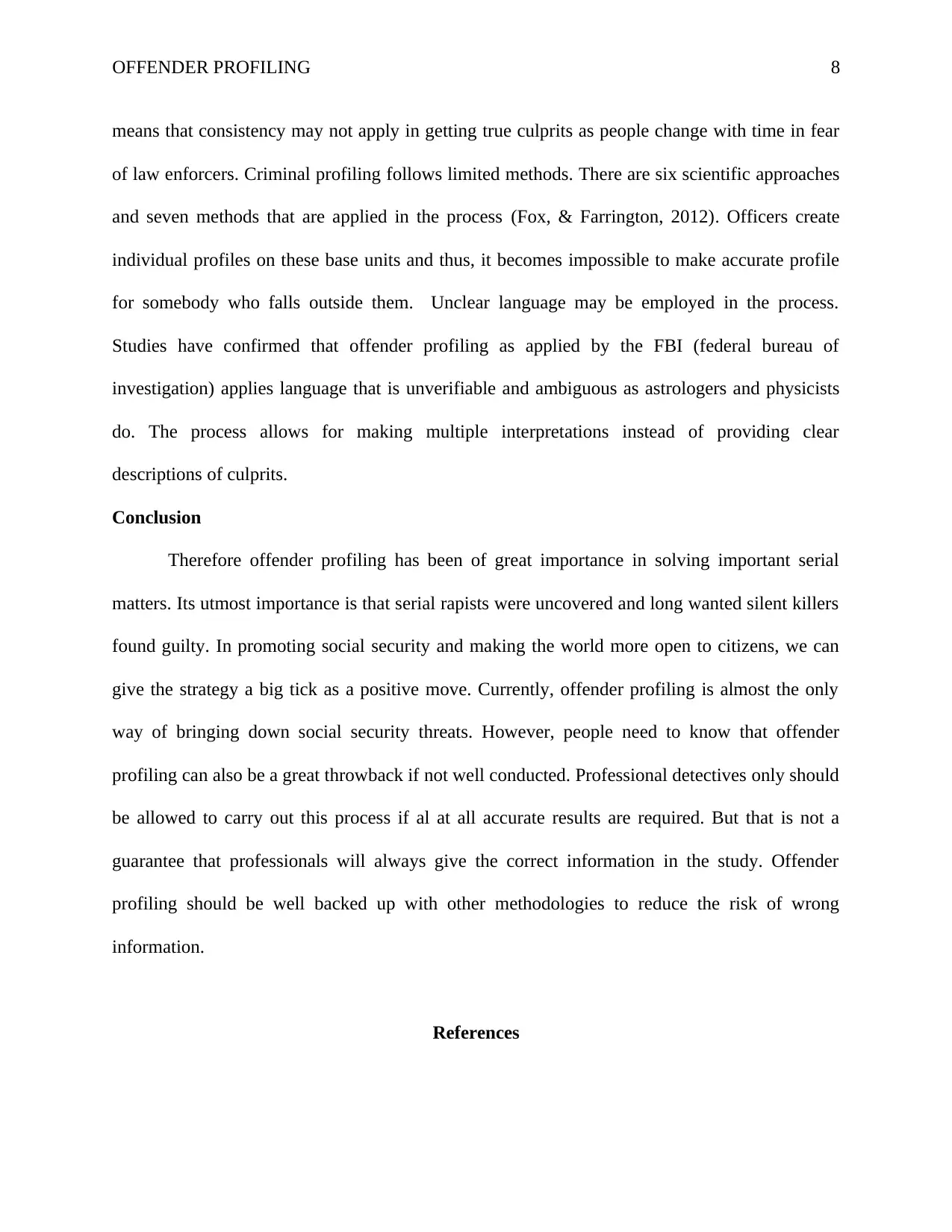
OFFENDER PROFILING 8
means that consistency may not apply in getting true culprits as people change with time in fear
of law enforcers. Criminal profiling follows limited methods. There are six scientific approaches
and seven methods that are applied in the process (Fox, & Farrington, 2012). Officers create
individual profiles on these base units and thus, it becomes impossible to make accurate profile
for somebody who falls outside them. Unclear language may be employed in the process.
Studies have confirmed that offender profiling as applied by the FBI (federal bureau of
investigation) applies language that is unverifiable and ambiguous as astrologers and physicists
do. The process allows for making multiple interpretations instead of providing clear
descriptions of culprits.
Conclusion
Therefore offender profiling has been of great importance in solving important serial
matters. Its utmost importance is that serial rapists were uncovered and long wanted silent killers
found guilty. In promoting social security and making the world more open to citizens, we can
give the strategy a big tick as a positive move. Currently, offender profiling is almost the only
way of bringing down social security threats. However, people need to know that offender
profiling can also be a great throwback if not well conducted. Professional detectives only should
be allowed to carry out this process if al at all accurate results are required. But that is not a
guarantee that professionals will always give the correct information in the study. Offender
profiling should be well backed up with other methodologies to reduce the risk of wrong
information.
References
means that consistency may not apply in getting true culprits as people change with time in fear
of law enforcers. Criminal profiling follows limited methods. There are six scientific approaches
and seven methods that are applied in the process (Fox, & Farrington, 2012). Officers create
individual profiles on these base units and thus, it becomes impossible to make accurate profile
for somebody who falls outside them. Unclear language may be employed in the process.
Studies have confirmed that offender profiling as applied by the FBI (federal bureau of
investigation) applies language that is unverifiable and ambiguous as astrologers and physicists
do. The process allows for making multiple interpretations instead of providing clear
descriptions of culprits.
Conclusion
Therefore offender profiling has been of great importance in solving important serial
matters. Its utmost importance is that serial rapists were uncovered and long wanted silent killers
found guilty. In promoting social security and making the world more open to citizens, we can
give the strategy a big tick as a positive move. Currently, offender profiling is almost the only
way of bringing down social security threats. However, people need to know that offender
profiling can also be a great throwback if not well conducted. Professional detectives only should
be allowed to carry out this process if al at all accurate results are required. But that is not a
guarantee that professionals will always give the correct information in the study. Offender
profiling should be well backed up with other methodologies to reduce the risk of wrong
information.
References

OFFENDER PROFILING 9
Alison, L., & Rainbow, L. (Eds.). (2011). Professionalizing offender profiling: Forensic and
investigative psychology in practice. Taylor & Francis.
Alison, L., Goodwill, A., Almond, L., van den Heuvel, C., & Winter, J. (2010). Pragmatic
solutions to offender profiling and behavioural investigative advice. Legal and
criminological psychology, 15(1), 115-132.
Beauregard, E. (2010). Rape and sexual assault in investigative psychology: the contribution of
sex offenders' research to offender profiling. Journal of Investigative Psychology and
Offender Profiling, 7(1), 1-13.
Canter, D. V. (2010). Offender profiling (pp. 236-241). Cambridge University Press.
Canter, D. V. (2011). Resolving the offender “profiling equations” and the emergence of an
investigative psychology. Current Directions in Psychological Science, 20(1), 5-10.
Canter, D. V., & Youngs, D. (2009). Investigative psychology: Offender profiling and the
analysis of criminal action. John Wiley & Sons.
Canter, D., Hammond, L., Youngs, D., & Juszczak, P. (2013). The efficacy of ideographic
models for geographical offender profiling. Journal of Quantitative Criminology, 29(3),
423-446.
Fox, B. H., & Farrington, D. P. (2012). Creating burglary profiles using latent class analysis: A
new approach to offender profiling. Criminal Justice and Behavior, 39(12), 1582-1611.
Goodwill, A. M., Alison, L. J., & Beech, A. R. (2009). What works in offender profiling? A
comparison of typological, thematic, and multivariate models. Behavioral sciences & the
law, 27(4), 507-529.
Alison, L., & Rainbow, L. (Eds.). (2011). Professionalizing offender profiling: Forensic and
investigative psychology in practice. Taylor & Francis.
Alison, L., Goodwill, A., Almond, L., van den Heuvel, C., & Winter, J. (2010). Pragmatic
solutions to offender profiling and behavioural investigative advice. Legal and
criminological psychology, 15(1), 115-132.
Beauregard, E. (2010). Rape and sexual assault in investigative psychology: the contribution of
sex offenders' research to offender profiling. Journal of Investigative Psychology and
Offender Profiling, 7(1), 1-13.
Canter, D. V. (2010). Offender profiling (pp. 236-241). Cambridge University Press.
Canter, D. V. (2011). Resolving the offender “profiling equations” and the emergence of an
investigative psychology. Current Directions in Psychological Science, 20(1), 5-10.
Canter, D. V., & Youngs, D. (2009). Investigative psychology: Offender profiling and the
analysis of criminal action. John Wiley & Sons.
Canter, D., Hammond, L., Youngs, D., & Juszczak, P. (2013). The efficacy of ideographic
models for geographical offender profiling. Journal of Quantitative Criminology, 29(3),
423-446.
Fox, B. H., & Farrington, D. P. (2012). Creating burglary profiles using latent class analysis: A
new approach to offender profiling. Criminal Justice and Behavior, 39(12), 1582-1611.
Goodwill, A. M., Alison, L. J., & Beech, A. R. (2009). What works in offender profiling? A
comparison of typological, thematic, and multivariate models. Behavioral sciences & the
law, 27(4), 507-529.
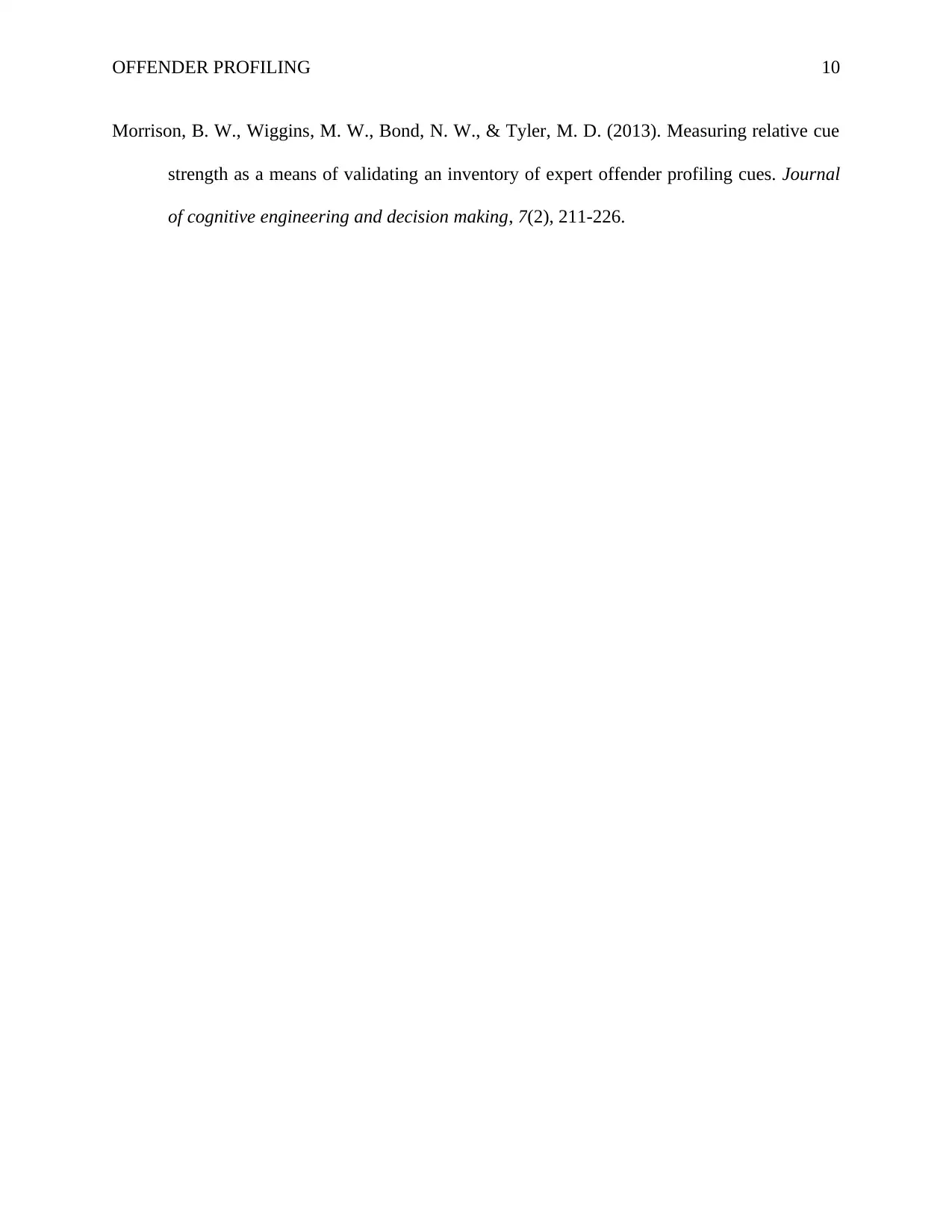
OFFENDER PROFILING 10
Morrison, B. W., Wiggins, M. W., Bond, N. W., & Tyler, M. D. (2013). Measuring relative cue
strength as a means of validating an inventory of expert offender profiling cues. Journal
of cognitive engineering and decision making, 7(2), 211-226.
Morrison, B. W., Wiggins, M. W., Bond, N. W., & Tyler, M. D. (2013). Measuring relative cue
strength as a means of validating an inventory of expert offender profiling cues. Journal
of cognitive engineering and decision making, 7(2), 211-226.
1 out of 10
Related Documents
Your All-in-One AI-Powered Toolkit for Academic Success.
+13062052269
info@desklib.com
Available 24*7 on WhatsApp / Email
![[object Object]](/_next/static/media/star-bottom.7253800d.svg)
Unlock your academic potential
© 2024 | Zucol Services PVT LTD | All rights reserved.





